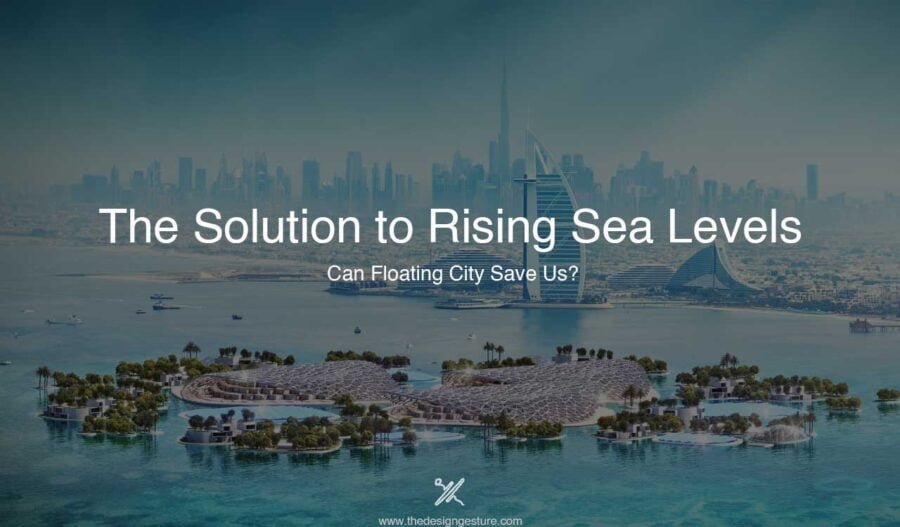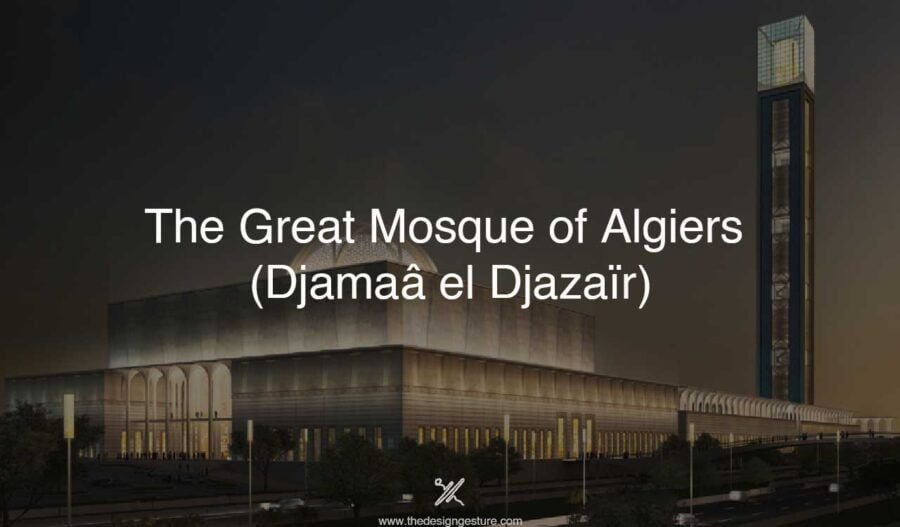Table of Contents
Floating City in the Limelight
Amidst the climate crisis, rising sea-water levels intertwined with a lack of space for accommodating the growing population, not to mention the already overcrowded cities, craze for waterfront developments, and the deteriorating aftereffects of reclamation, the floating city developments have fallen in the limelight. Floating developments are viewed as a sustainable alternative to land reclamation in the process of creating new lands for habitation.
It is predicted by the C40 network of global cities that due to sea-level rise and inland flooding, the coastal communities are at risk, with a possibility of over 800 million people, living in 570 cities around the world, getting affected, causing a loss of $1 trillion by 2050.
The responsibility of combatting this catastrophe is entrusted to the floating city developments. While small-scale floating city projects like Floating Farm Dairy in Rotterdam, Floating Office in Rotterdam, Salmon Eye in Norway; a floating aquaculture exhibition and visitor center, etc. are constructed and underuse, humungous floating urban districts still remain under construction or as concepts yet to be explored.
Spearheaders of Floating City
Many countries and experimenting with pilot floating projects and many novel marine and floating architecture research institutions mushroomed driving floating city developments worldwide. For instance, the Maldives is prone to the risk of flooding as 80 percent of its land is less than 1 meter above sea level and the concerned have come up with the floating city of Maldives seeking a viable solution beforehand.
But the case of Singapore and Busan is quite different with relatively calm waters. In Singapore and Busan, there is a dearth of land which is aimed to be solved by floating architectural solutions like designing floating units to expand the port in Singapore and planning a large floating city for housing, research, and tourism in Busan. The idea of expanding ports with floating modules is quite rewarding as it provides relief from the chaos of permanent intervention like landfills yet allows the construction of additional space in the port for distinct other functions that pop up occasionally.
Norway is another spearheading country with regards to exploring the various uses of floating developments, not just floating urban districts. Norwegian cities are pioneers of floating recreational spaces like floating saunas, rental floating holiday homes, etc. that free the main city centers for at least some time during the summers. Besides above discussed countries, Dutch Docklands International BV, based in the Netherlands, is an unconventional private construction company founded in 2005, that specializes in constructing on-water and floating developments.
It has gained its expertise from Netherlands efforts to combat flooding and developed its own patented software programs; The Dutch Docklands Fingerprints and Dutch Docklands Comfort Targets to come up with unique place-based solutions. In 2021, Dutch Docklands International BV launched one of the first floating cities in the world, the state-of-the-art Maldives Floating City spearheading the floating city projects. SFI BLUES is a Norwegian-based research center that explores and creates innovative floating structures, that will support aquaculture, generate renewable energy, and act as coastal infrastructure. SINTEF Ocean is the host institution for SFI BLUES, and SFI BLUES collaborates with various institutions and researchers, industry partners to discover innovative applications for floating structures.
Floating Cities Under Conceptualization, Research and Construction
In the context of climate change, rising sea levels, and budding innovations to tackle these changes, a sustainability race is running between the collaboration of researchers, construction industry partners, and countries, as to who comes up with the best sustainable solution first and how outspread and attractive it is. This race has given rise to a considerable number of such conceptual projects with seductive renders and utopian stories to tell.
Even though the novel floating city projects seem extravagant and are only under development, these projects upon implementation will mark a paradigm shift and will open up newer possibilities of living not only on water but also in harmony with it. Some such floating city projects in developmental stages are Dogen City conceptualized by Japanese startup N-Ark, Oxagon floating port city of Neom in Saudi Arabia, Dubai Reefs, Maldivian floating city, Oceanix City in Busan, etc.
Oceanix City, Busan
The OCEANIX city, Busan born out of a collaboration of UN-Habitat, blue tech firm OCEANIX, Bjarke Ingels Group, SAMOO Architects and Engineers, Arup, the MIT Center for Ocean Engineering, the Korea Maritime and Ocean University, environmental artist Olafur Eliasson and Studio Other Spaces, the Center for Zero Waste Design and the Global Coral Reef Alliance as the world’s first prototypical sustainable floating city. The OCEANIX city spreads over 15.5 acres as interconnected platforms with a capacity of 12,000 people.
The buildings are low-rise, soft-edged, and have plenty of terraces facilitating indoor-outdoor connections and outdoor living. The project is self-sufficient, sustainable, and resilient as it integrates solar energy-generating floating and rooftop photovoltaic panels, zero waste and circular systems, closed-loop water systems, net-zero energy, innovative mobility, and coastal habitat regeneration. Having the potential to expand and accommodate more than 100,000 people, OCEANIX City in Busan has yet to cause a drastic change in design thinking.
Maldives Floating City
Maldives Floating City is a floating urban district development of Dutch Docklands International BV in a joint venture with the Government of Maldives designed by Waterstudio.NL inspired by brain corals. The floating island is only ten minutes away from the capital city of Maldives, Male by boat. Reflecting upon the Maldives as a seafarers nation and epitomizing the city as a boating community, mobility in and to the city is planned mainly using canals, limiting the conventional land-based movement to walking and biking on sand roads rather than asphalt ones.
It is a sustainable initiative as no cars are allowed. The network of canals resembles the brain coral as it was the main conceptual anchor of the design team. The idea of corals was extended further in the project, by creating artificial coral banks to the underside of the floating city, such that it will stimulate coral to grow naturally as corals are natural wave breakers and provide safety to the residents on the floating houses. With its noble intention of projecting ‘living with nature, learning to improve and respect natural coral at the heart of the development’, the Maldives floating resilient city has set the bar high for other such developments.
Dubai Reefs
URB unveiled Dubai Reefs, the world’s largest floating ocean restoration and ecotourism project, which is only at the research and conceptual stage. Upon solving the issues of commercial viability and depending on when the funding is received, the first phase of Dubai reefs could be realized by 2025 to 2030.
Artificial reef housing over a billion corals and 100 million mangrove trees is a key component of the project, besides, the marine institute that promotes marine science and conservation in Dubai, the floating eco-lodges for marine eco-tourism exclusively running on renewable solar power and hydropower, and wave farms that cater to Dubai’s energy needs. Regenerative ocean farming is also a component of the project that deals with sustainable food production and food security. Dubai Reefs is quite an ambitious pilot project that upon realization can serve the greater good it intended to.
Other Small Scale Floating Projects
Unlike the large-scale projects that only remain in renders and are under process, the small-scale floating structures have made it to reality. They sort of convey the possibility of ‘living on water’, and allow further exploration in the direction of larger floating developments and a chance to rectify the mistakes before applying them to the bigger picture. Arkup 75 is a modern sleek yacht villa designed by Waterstudio.NL that can both sail and stay stationary on water with its innovative foundation with anchorable steel stilts (spuds).
Arkup 75 can work off the grid due to the voltaic panels mounted on its roof. Whereas Floating Bamboo Houses or FB Houses conceptualized by H&P Architects are warm and cozy. It was envisioned as a safe alternative for the poor households of Vietnam especially in areas of the Mekong Delta and the Red River Delta who are at risk of a rise in sea level by at least one meter.
Amidst residential floating structures, floating developments accommodate farms, office spaces, visitor centers, research centers, museums, etc. For Instance, the Floating Farm Dairy in the Meuse River is a one-of-a-kind agricultural innovation, research, production, and educational facility envisioned and initiated by Peter and Minke van Wingerden, and designed by Goldsmith Company.
The farm is a 3-story structure that houses 40 cows in a cow garden with cleaning and milking robots on the topmost floor, retail and other technical systems like milk and yogurt processing, feeding, and, manure handling systems are located on the intermediate translucent floor and the opaque concrete pontoons in the lowermost floor hosts the heavy technical components, services including rain and wastewater recycling and cultivation of fruits for production of flavored yogurts. Salmon Eye, the Floating Kayak Club, AntiRoom II Pavilion, The Exbury Egg, and Floating Street of Nassauhaven, all manifest the likelihood of other such innovative floating developments.
Sustainable Floating Urban Districts; Busting the Myth
Floating cities are projected as sustainable alternatives, like a utopia on water. But, in reality, floating cities are not sustainable by themselves. Upon working in collaboration with other sustainable systems like solar power generation, hydropower generation, seawater desalination, etc. floating cities reach the desired sustainability standards. Well, in fact, anything built on land or on water, if anchored or floating creates an impact on the host. While it may seem sustainable to create floating structures rather than reclaim land out of water altering shorelines or creating independent artificial islands, the floating structure also affects the natural marine environment.
For instance, they can block the natural amount of sunlight that enters the ocean which can even prove fatal for some marine flora or it could emit sounds that disturb the intrinsic aqua environment leading to biodiversity loss. It is important to understand the implications of floating structures on water bodies and aquatic life and to design strategies to prevent the loss of biodiversity or any other adverse effects on the environment. The development of floating urban districts is definitely a paradigm shift and with meticulous research and environmental consciousness it can turn out to be a step closer towards a sustainable future, in harmony with nature.
FAQ
- What are pontoons?
Pontoons are a type of flotation device designed to provide buoyancy and stability to various structures, such as boats, docks, and other water-based platforms. Typically, pontoons are hollow, airtight tubes or containers made of durable materials like steel, aluminum, or fiberglass, which are capable of displacing a significant volume of water. This displacement creates an upward force, known as buoyancy, that counteracts the weight of the structure, allowing it to float on the surface of the water. Pontoons are commonly used in the construction of houseboats, floating homes, and large-scale aquatic infrastructure projects, such as bridges and marinas.
- What are some of the floating techniques used in floating architectural projects?
Several innovative techniques are employed in floating architectural projects. One such technique is the use of pontoons, which are floating structures that provide buoyancy to the building. Another method is the incorporation of hollow concrete foundations, which reduce the weight of the structure while increasing its buoyancy. Lastly, air-filled compartments or inflatable modules are used as foundations in some projects to provide lift and stability to the floating structure.




